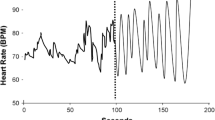Abstract
The main aim of the present research was to determine the effectiveness of biofeedback-aided relaxation training (BFRT) for alleviating symptoms of depression, anxiety, and stress for undergraduate students as they prepared for their final examinations. In a randomized controlled trial design, 29 male and female students, with heightened levels of depression, anxiety and stress scores on the Depression, Anxiety, and Stress Scale, were chosen and randomly assigned to BFRT or a no-treatment control condition. Subjects assigned to BFRT received eight sessions of BFRT spaced over 4 weeks, during which they were trained to decrease electromyography (EMG) and respiration rate (RESP) and to increase skin temperature (TEMP). Data were extracted and analyzed by GLM statistical analysis. Students receiving BFRT revealed significant reductions in symptoms when compared to the untreated controls. Those receiving BFRT also showed significant changes for the three targeted psychophysiological modalities (EMG, RESP, and TEMP). It was concluded that BFRT can be useful for reducing symptoms of emotional disturbance in undergraduate students during a particularly stressful period and that this may, in turn, help promote overall psychological health.


Similar content being viewed by others
References
Anstead, S. J. (2009). College students and stress management: Utilizing biofeedback and relaxation skills training. Brigham Young University, Degree of Education Specialist’s Thesis.
Brown, T. A., Chorpita, B. F., Korotitsch, W., & Barlow, D. H. (1997). Psychometric properties of the depression anxiety stress scales (DASS) in clinical samples. Behavior Research and Therapy, 35(1), 79–89.
Calderon, K. S., Thompson, W. W. (2004). Biofeedback relaxation training: A rediscovered mind-body tool in public health. American Journal of Health Studies, 19(4), 185.
Chang, E. C. (1998). Hope, problem-solving ability, and coping in a college student population: Some implications for theory and practice. Journal of Clinical Psychology, 54(7), 953–962.
Crawford, J. R., & Henry, J. D. (2003). The Depression Anxiety Stress Scales (DASS) normative data and latent structure in nonclinical sample. British Journal of Clinical Psychology, 42(12), 111–121.
Fehring, R. J. (1983). Effects of biofeedback-aided relaxation on the psychological stress symptoms of college students. Nursing Research, 32(6), 362–366.
Frank, D. L., Khorshid, L., Kiffer, J. F., Moravec, C. S., & McKee, M. G. (2010). Biofeedback in medicine: Who, when, why and how? Mental Health in Family Medicine, 7, 85–91.
Gerdes, H., & Mallinckrodt, B. (1994). Emotional, social, and academic adjustment of college students: A longitudinal study of retention. Journal of Counseling and Development, 72, 281–287.
Henriques, G., Keffer, S., Abrahamson, C., & Horst, S. J. (2011). Exploring the effectiveness of a computer-based heart rate variability biofeedback program in reducing anxiety in college students. Applied Psychophysiology and Biofeedback, 36, 101–112.
Hurley, J. D., & Meminger, S. R. (1992). A relapse prevention program: Effects of electromyographic training on high and low levels of state and trait anxiety. Perceptual and Motor Skills, 74(3 Pt 1), 699–705.
Kessler, R., Soukup, J., Davis, R., Foster, D., Wilkey, S., Van Rompay, M., & Eisenberg, D. (2001). The use of complementary and alternative therapies to treat anxiety and depression in the United States. American Journal of Psychiatry, 158(20), 289–294.
Lazarus, R. S., & Cohen, J. (1977). Environmental stress. In J. Wohlwill & I. Altman (Eds.), Human behaviour and environment (pp. 90–127). New York: Plenum.
Lovibond, P. F. & Lovibond, S. H. (1995). The structure of negative emotional states: Comparison of the depression anxiety stress scales (DASS) with the Beck depression and anxiety inventories. Behaviour Research and Therapy, 33(3), 335–343.
MacGeorge, E. L., Samter, W., & Gillihan, S. (2005). Academic stress, supportive communication, and health. Communication Education, 54, 365–372.
Peira, N., Fredrikson, M., & Pourtois, G. (2014). Controlling the emotional heart: Heart rate biofeedback improves cardiac control during emotional reactions. International Journal of Psychophysiology, 91(3), 225–231.
Prato, C. A. (2009). Biofeedback assisted relaxation training program to decrease test anxiety in nursing students. The dissertation of Doctor of Philosophy in Nursing School of Nursing Division of Health Sciences Graduate College University of Nevada, Las Vegas. UMI 3396342. Copyright 2010 by ProQuest LLC.
Sarafino, E. P. (2006). Health psychology: Biopsychosocial interactions (5th ed.). Hoboken: Wiley.
Schoenberg, P. L., & David, A. S. (2014). Biofeedback for psychiatric disorders: A systematic review. Applied Psychophysiology and Biofeedback, 39(2), 109–135.
Siepmann, M., Aykac, V., Unterdörfer, J., Petrowski, K., & Mueck-Weymann, M. (2008). A pilot study on the effects of heart rate variability biofeedback in patients with depression and in healthy subjects. Applied Psychophysiology and Biofeedback, 33, 195–201.
Sternbach, R. (1966). Principles of psychophysiology: An introductory text and readings. San Diego, CA: Academic Press.
Thompson, J. G., Griebstein, M. G., & Kuhlenschmidt, S. L. (1980). Effects of EMG biofeedback and relaxation training in the prevention of academic underachievement. Journal of Counseling Psychology, 27(2), 97–106.
Vitasari, P., Wahab, M. N. A., Herawan, T., Sinnadurai, S. K. (2011). Psychophysiological treatment in reduced anxiety with biofeedback training for university students. Procedia-Social and Behavioral Sciences, 30, 629–633.
Acknowledgements
This article is extracted from a thesis for degree of Masters of Art in psychology by Zahra Gholami Tahsini, supervised by Dr.Shahrokh Makvand Hosseini and analyzed statistically by Dr.Farahnaz Kianersi as the advisor of the thesis. Two PhD candidates, Shahrzad Rashn and Elaheh Majdara helped in writing the manuscript and English editing as well. All experimental works were conducted in the Psychophysiology Laboratory of Semnan University, the Faculty of Psychology and Educational Sciences.
Author information
Authors and Affiliations
Corresponding author
Rights and permissions
About this article
Cite this article
Gholami Tahsini, Z., Makvand Hosseini, S., Kianersi, F. et al. Biofeedback-Aided Relaxation Training Helps Emotional Disturbances in Undergraduate Students Before Examination. Appl Psychophysiol Biofeedback 42, 299–307 (2017). https://doi.org/10.1007/s10484-017-9375-z
Published:
Issue Date:
DOI: https://doi.org/10.1007/s10484-017-9375-z




